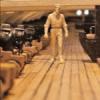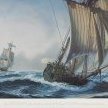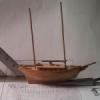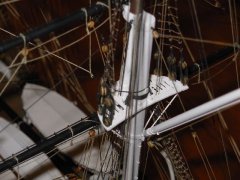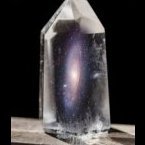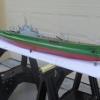Supplies of the Ship Modeler's Handbook are running out. Get your copy NOW before they are gone! Click on photo to order.
×
-
Posts
3,462 -
Joined
-
Last visited
Reputation Activity
-
 amateur got a reaction from popeye the sailor in HMS Victory by dafi - Heller - PLASTIC - To Victory and beyond ...
amateur got a reaction from popeye the sailor in HMS Victory by dafi - Heller - PLASTIC - To Victory and beyond ...
Digital painting. Ideal when science discovers that it was actually red and yellow in stead of black and white.
Why thoses small pieces above and under the upper gunports?
Jan
-
 amateur reacted to G.L. in Fishing Smack c. 1920 by G.L. - FINISHED - Scale 1/20 - POF - cross-section
amateur reacted to G.L. in Fishing Smack c. 1920 by G.L. - FINISHED - Scale 1/20 - POF - cross-section
The deck beams which meet frames are reinforced with iron knees. I make them out of strips of brass (I apologize for the blurry images).
Nail holes in the knees.
After they are blackened, I nail them on the deck beam.
Marking and drilling the nail holes in the hull. I will not fasten the deck beam immediately to the model before I made some progress to the fish hold.
The fish hold could be divided in small cubus-shaped compartments by mean of removable planks to stow away the fish with ice. In the fish hold stood wooden vertical pillars with slots in it to hold the planks. I will only place some planks to make clear how it was like.
From the late 19th century on, fishermen who went for a couple of days to sea stored their catch between layers of ice. In those days winter ice was shipped from Norway to our fishery ports. After the first World War fishermen took factory made ice with them. On certain vessels they used some of the fish compartments to store ice. On other boats there was a special insulated ice container on board.
For this cross section Mr. Verleene relies to the construction of a Flemish (Belgian) fishing vessel. The icebox was made of a slat construction with cork plates in between and that all was covered with galvanized or zinc plates. The box could contain approx. 1200 kg ice.
I start by making the container sides. They are made off horizontal paneling. To give it all a bit of initial strength I glue a piece of waste paper on the inside of the walls. It will soon be covered by the inner lining of the icebox.
I don't have to imitate the cork insulation material, I use real cork, namely a wine cork. I saw the cork in slices.
I glue a cork layer on the edge of the icebox wall.
The galvanized plates are made of tin-plate.
The plates were nailed on the slat construction. I imitate the nails by punching them in the plate.
The tin is a bit too glossy, therefore I rub it in with tiffany patina to give it a zinc look.
Gluing the plates.
The ice compartment is entirely plated. The plate right below is corroded due to a bit too long contact with the tiffany patina. I will sand it slightly.
-
 amateur got a reaction from mtaylor in Hello from Holland
amateur got a reaction from mtaylor in Hello from Holland
The Groene Draak was a wedding present from the Dutch people to Prinses Beatrix and Prins Claus.
Not a very 'royal design', on the contrary, it was based on the rather common flat bottomed working ships there used to be.
Jan
-
 amateur reacted to dafi in HMS Victory by dafi - Heller - PLASTIC - To Victory and beyond ...
amateur reacted to dafi in HMS Victory by dafi - Heller - PLASTIC - To Victory and beyond ...
Just patches, to be omitted in the final version 🙂
-
 amateur got a reaction from popeye the sailor in Smit Rotterdam by Sjors - Billing Boats - 1:75 - Sea tug
amateur got a reaction from popeye the sailor in Smit Rotterdam by Sjors - Billing Boats - 1:75 - Sea tug
Weird.....
I would think the oldfashioned way (just strips) work better.
Jan
-
 amateur got a reaction from pontiachedmark in USS Constitution by lowsodiumsailor - Mamoli - 1:93 - first build
amateur got a reaction from pontiachedmark in USS Constitution by lowsodiumsailor - Mamoli - 1:93 - first build
Hi,
I do not have much experience, but thekits I did, used presawm frames. These were not lasercut, but just machine sawn. The deviations were, to say the least, on the large side. I guess there is a drawing that shows you how it should look. These drawings are not included for nothing.....
one of the major issues in the machine cut frames is the centerslot out of the centerline, and/or not of the correct length, resulting in the frame sitting too low or too high. Basic rule measure twice (at least), glue once.
with respect to your other question: The kit makers have standardsizes of wood. Planks/dowels etc, notmade to the specs of your model, but the other way round: the size of the model is determined by the size of the wood available.
In most cases the wood provided in the kit is the first standard size available above the measure you need. Sometimes that is really close to the final size, sometimes you need some resizing. In the kits I did, mastsizes and available wood did coincide rather well.
Jan
-
 amateur got a reaction from dafi in HMS Victory by dafi - Heller - PLASTIC - To Victory and beyond ...
amateur got a reaction from dafi in HMS Victory by dafi - Heller - PLASTIC - To Victory and beyond ...
How many will there be in this display?
I think the Maya die Biene version should be included....;)
Jan
-
 amateur got a reaction from lmagna in King George V by kpnuts - FINISHED - Tamiya - 1/350 - PLASTIC
amateur got a reaction from lmagna in King George V by kpnuts - FINISHED - Tamiya - 1/350 - PLASTIC
Interesting car in the background.
never knew that Citroen did this kind of stuff.. Kit, or own modification?
Jan
-
 amateur got a reaction from Canute in King George V by kpnuts - FINISHED - Tamiya - 1/350 - PLASTIC
amateur got a reaction from Canute in King George V by kpnuts - FINISHED - Tamiya - 1/350 - PLASTIC
Interesting car in the background.
never knew that Citroen did this kind of stuff.. Kit, or own modification?
Jan
-
 amateur got a reaction from popeye the sailor in King George V by kpnuts - FINISHED - Tamiya - 1/350 - PLASTIC
amateur got a reaction from popeye the sailor in King George V by kpnuts - FINISHED - Tamiya - 1/350 - PLASTIC
Interesting car in the background.
never knew that Citroen did this kind of stuff.. Kit, or own modification?
Jan
-
 amateur got a reaction from mtaylor in King George V by kpnuts - FINISHED - Tamiya - 1/350 - PLASTIC
amateur got a reaction from mtaylor in King George V by kpnuts - FINISHED - Tamiya - 1/350 - PLASTIC
Interesting car in the background.
never knew that Citroen did this kind of stuff.. Kit, or own modification?
Jan
-
 amateur got a reaction from cog in King George V by kpnuts - FINISHED - Tamiya - 1/350 - PLASTIC
amateur got a reaction from cog in King George V by kpnuts - FINISHED - Tamiya - 1/350 - PLASTIC
Interesting car in the background.
never knew that Citroen did this kind of stuff.. Kit, or own modification?
Jan
-
 amateur got a reaction from mtaylor in Hello from Holland
amateur got a reaction from mtaylor in Hello from Holland
Hi Marcel,
Welcome to MSW!
Is your Groene Draeck a kit, or based on a drawing?
Jan
-
 amateur got a reaction from dafi in Prins Willem by amateur - Corel - 1:100
amateur got a reaction from dafi in Prins Willem by amateur - Corel - 1:100
As daylight didn't quite return, I took some pics with a flash.
Flash and close-up results in suboptimal pics, I know......
I am a bit struggling with the Amati-line: it was sold as 'pure natural', but white glue doesn't have much of an effect on it: when the glue sets, it holds the rope-coils together, but as soon as I apply some white glue to it to fix it onto the deck, the line becomes springy again, and goes all over the place. Difficult to get naural coils in that way: I need to harden the glue completely around the dowel, resulting in coils that are completely circular on the inside, and a bit too high.
The hanging coiols are formed in the way Edt showed them with Yound America: again: the rop wants to go in every direction, So I need the coils completely glued down. The Corel stuff (although looking a bit polyester-like (glossy), does handle quite a lot better in forming the ropes and gluing them down.
Two pics of the Focsle:
The space around the main mast: (yes, there lies a drill-bit, to hold the rope down to its place while the glue sets....)
And one of the foot of the mizzen:
Perhaps I can do some more today, but without sunlight in my working space, and with rope that doesn't want to do what I want it to do, it is slow going.
Jan
-
 amateur got a reaction from EJ_L in King George V by kpnuts - FINISHED - Tamiya - 1/350 - PLASTIC
amateur got a reaction from EJ_L in King George V by kpnuts - FINISHED - Tamiya - 1/350 - PLASTIC
Interesting car in the background.
never knew that Citroen did this kind of stuff.. Kit, or own modification?
Jan
-
 amateur got a reaction from etubino in V108 Torpedo Boat by amateur - FINISHED - Digital Navy - 1:200 - CARD
amateur got a reaction from etubino in V108 Torpedo Boat by amateur - FINISHED - Digital Navy - 1:200 - CARD
I warned you: the size of the parts is getting smaller and smaller.
So here is the update of two afternoons of cutting, rolling (ugly words because of the carpet monster), and glueing.
Using a flash when taking pictures at close distance with a cellphone, makes the not-so-good even worse All in all I am not too unhappy.
Some miscellaneous goodies awiting a bit of grey paint to cover the white.
some really small stuff (winches and the bearing ring for the torpedotubes)
and when youthink life can't get worse, you encounter this:
which turned into this (took me the better part of an hour)
again, some grey needed to do some covering up. Not now, as the card is still a bit unstable due to the water in the glue. (No, I am not going to use CA for this: far too small too handle for me. I need safe glue)
and some present state pics.
Fore deck with whinch and water breaker
Cabin with stearing gear, lights and support struts.
And the last one: all the little stuff installed (except for that range finder)
flash highlights the white sides, even when they are harly visible to the eye in normal daylight circumstances.
And now my eyes need something easy
Jan
-
 amateur got a reaction from etubino in V108 Torpedo Boat by amateur - FINISHED - Digital Navy - 1:200 - CARD
amateur got a reaction from etubino in V108 Torpedo Boat by amateur - FINISHED - Digital Navy - 1:200 - CARD
I got the deck closed, but unfortunatedly, the pressure needed for that made the hull crack (just under the glueing tab attached to the hull)
and I will redo the superstructure. The parts are ready, but the paint on the deck edge needs to dry before I start gluing (waterbased glue, so it will not grab on a wet / damp surface)
both decks are rounded the same way, so I hope that there will be no twisting this time. No building time tomorrow, so plenty of drying time
Jan
-
 amateur got a reaction from etubino in V108 Torpedo Boat by amateur - FINISHED - Digital Navy - 1:200 - CARD
amateur got a reaction from etubino in V108 Torpedo Boat by amateur - FINISHED - Digital Navy - 1:200 - CARD
Yip, solvent one.
I discarded the pva, as it tended to leave visible changes in the card due to rhe water, might switch back to PVA though,
below the promised pics: bow and stern closed. No problems (apart from fingers wirh glue )
-
 amateur reacted to RGL in SMS Seydlitz by Canute, Cog, Stein Gildberg & RGL - FINISHED - Hobbyboss - 1/350 - PLASTIC
amateur reacted to RGL in SMS Seydlitz by Canute, Cog, Stein Gildberg & RGL - FINISHED - Hobbyboss - 1/350 - PLASTIC
Hull weathering done up to the point where I have to add the decks
-
 amateur reacted to FingerSticker in Revenge by FingerSticker - Shipyard - 1/96 - CARD
amateur reacted to FingerSticker in Revenge by FingerSticker - Shipyard - 1/96 - CARD
Good evening, all!
Hope we all survived the holidays as well as can be expected and I hear this year that last year Richmond didn't get a white Christmas ..... again! If it makes you feel better, Richmond, neither did I .... again! 😢
To make matters worse, this new dope didn't make it fun at all, as Ron predicted, but more about the dope-situation later.
There's a lot to show about the work that's been going on in Leicester, so without further ado ...
I hope you all remember that i was going to check to position of the first planking layer with regards to the inside wall pieces. Most of them were quite spot on, another show that the design of this ship is A**!
Using the windows in the inside card as datum points I got almost perfect fit on the aft section of the planking card.
The front section was already in place and fitted well too. Just the middle section was out. Way out even. It was so bad, that I decided to perform some corrective surgery on that section, even though I said in the past that the fit would not matter that much. But if the windows are badly out of whack then the above lying railings will be out of whack too and it would be much easier to rectify the situation as soon as possible. So a quick flick with the knife in the right position and the offending section was cut away.
You can see on the right, where the bottom of the red card lined up with the glue line, that there was a discrepancy of 1 to 2 mm. Using the windows as guide and glueing down the red card (after careful bending) gave a much better looking situation.
It also gave an improved situation because the wall was slightly bigger than the red card so it would give a little ridge to use when glueing down the section to the forecastle area. That worked so well, that I decided to do the same for the right hand side, i.e. glue down the red card in the correct position before glueing the planking card into its position on the right hand side. But more about the right hand side later.
This was the time that I thought it best to try out this new dope on the now completed left hand side.
As I had no experience with this new fan-dangled dope that doesn't smell but is water based, I decided to create a little platform to try it out on card.
A simple box with the sides kept free combined with a slightly oversized piece of standard card. Since it IS card and the dope is water based, I thought it best to try it neat, i.e. undiluted. The liquid was quite thick and opaque and smelled of nothing. So, at least that part was as expected. But it brushed down without a problem and stayed basically on top of the card.
Since this is the strongest I can use this liquid, I was interested to see how much pull this would create on the card after drying. Which was not nearly as much as I expected or hoped for.
I must admit I found the distortion underwhelming. When tapping the dried card with a pen it pinged slightly like a drum but nowhere near as much as I remembered from the old dope on my balsa aircraft. So, is this new dope like all the other replacements for environmental reasons, and not work as well as the intoxicating and 'dirty' old stuff? Or did I not use it correctly?
(To be honest, not having tried the old dope on a card model like the one I am working on now, it could also be that dope (either version) doesn't work that well with card and cardboard.)
I decided to follow the manufacturers ,made a 30% solution in a little tray and used that on a piece of card as well paper. Well, that worked!
The card piece still showed a little amount of distortion as before but sounded a lot 'pingier' when struck with a pen, whereas the paper behaved as expected and rolled itself up during drying. I reckoned the dope needed the water to be absorbed more, i.e. get more into the card rather than just lay on top.
That would be good, because I tried some filler onto the neat dope card.
After drying I could rub off the filler just with one finger! Obviously this filler doesn't work on dope and to use it I would have to sand down the dope layer, which would probably also remove the strength improvement that I was after!
Seeing the limited distortion on the card I felt confident to trial the 30% solution on the left hand side of the model.
Well, it's not an unmitigated disaster. 😢 And the surface is tougher so that at least worked. It was only now that I realised that I did all trials with 0.3 mm card and the bottom pieces were 'only' 0.16 mm thick, so more like paper (0.08 mm) than the card and would therefore want to roll up more like the piece of paper in the trial. It should still be fine, since I needed to fill that side anyway to get rid of ridges and gouges. It will just need more filler to also fill the card depressions.
I decided to continue the planking for the right hand side whilst considering what to do with that side coating-wise.
I fitted the middle section this time first after glueing the red inside piece to the planking piece as I did on the left hand side, then offered it up to the side of the ship, bend the pieces by hand to get a snug fit then glued the piece down.
I let that dry thoroughly before adding the forecastle front (part 62), which required a little more finger bending of the front of the planking sides to fit with the angles on the front piece.
During the placing of the planking piece on the right hand side I found a number of frames that had been completely covered by the bottom planking pieces and left the ridges of this planking pieces unattached. Next time I will not use horizontal strips alongside the side of the ship but glue down a 1 cm wide strip of paper vertically along all frames which should give all sections a wide enough area to attach to on either side of the frame.
And since both sides need a relatively heavy filler load anyway, I decided to learn a bit more about the dope. Was there a magic concentration that would work? I decided to try a new concentration, one that would lie in the middle of the ones already trialled (i.e. a 100% and a 30% mix). For the mathematically interested followers, I decided on a 65% solution, which I mixed up by transferring 13 ml of dope and 7 ml of water with a 5 ml syringe into a little container, mix it up and slap it on.
There are still distortions after drying, less than before but still clearly visible whilst leaving a shine on the card, showing that there was too much of the dope being left on top of the card. The card is stiffer than it was with the 30% solution (the ping was higher in pitch) but stiff enough?
We will have to see how this will affect the placing of filler but that is for later.
On the whole, I am not impressed by this 'eze dope', even though I do not have a reference to place against it apart from some memories from the past when using 'stinky' dope on tissue paper. As said before I do not know whether it would work at all with thicker card so I might have just barged through an open door. That wouldn't be the first time, I can assure you!
I am relieved that my 'desire' to experiment didn't lead to a total destruction of the model that I have been lovingly working on. And will continue to lovingly work on. First i will need to add the poop deck aft wall (part O) from way, way before, then I will trim the planking cards to lie flush where needed and then it will be a glorious battle between me and a pallet knife against a ship and a tub of wood filler with plenty of sanding during the rest periods.
I'll be in touch once the smoke has lifted from the battlefield!
-
 amateur got a reaction from J11 in Prins Willem by amateur - Corel - 1:100
amateur got a reaction from J11 in Prins Willem by amateur - Corel - 1:100
As daylight didn't quite return, I took some pics with a flash.
Flash and close-up results in suboptimal pics, I know......
I am a bit struggling with the Amati-line: it was sold as 'pure natural', but white glue doesn't have much of an effect on it: when the glue sets, it holds the rope-coils together, but as soon as I apply some white glue to it to fix it onto the deck, the line becomes springy again, and goes all over the place. Difficult to get naural coils in that way: I need to harden the glue completely around the dowel, resulting in coils that are completely circular on the inside, and a bit too high.
The hanging coiols are formed in the way Edt showed them with Yound America: again: the rop wants to go in every direction, So I need the coils completely glued down. The Corel stuff (although looking a bit polyester-like (glossy), does handle quite a lot better in forming the ropes and gluing them down.
Two pics of the Focsle:
The space around the main mast: (yes, there lies a drill-bit, to hold the rope down to its place while the glue sets....)
And one of the foot of the mizzen:
Perhaps I can do some more today, but without sunlight in my working space, and with rope that doesn't want to do what I want it to do, it is slow going.
Jan
-
 amateur got a reaction from Mirabell61 in Prins Willem by amateur - Corel - 1:100
amateur got a reaction from Mirabell61 in Prins Willem by amateur - Corel - 1:100
As daylight didn't quite return, I took some pics with a flash.
Flash and close-up results in suboptimal pics, I know......
I am a bit struggling with the Amati-line: it was sold as 'pure natural', but white glue doesn't have much of an effect on it: when the glue sets, it holds the rope-coils together, but as soon as I apply some white glue to it to fix it onto the deck, the line becomes springy again, and goes all over the place. Difficult to get naural coils in that way: I need to harden the glue completely around the dowel, resulting in coils that are completely circular on the inside, and a bit too high.
The hanging coiols are formed in the way Edt showed them with Yound America: again: the rop wants to go in every direction, So I need the coils completely glued down. The Corel stuff (although looking a bit polyester-like (glossy), does handle quite a lot better in forming the ropes and gluing them down.
Two pics of the Focsle:
The space around the main mast: (yes, there lies a drill-bit, to hold the rope down to its place while the glue sets....)
And one of the foot of the mizzen:
Perhaps I can do some more today, but without sunlight in my working space, and with rope that doesn't want to do what I want it to do, it is slow going.
Jan
-
 amateur got a reaction from Ferit in Prins Willem by amateur - Corel - 1:100
amateur got a reaction from Ferit in Prins Willem by amateur - Corel - 1:100
As daylight didn't quite return, I took some pics with a flash.
Flash and close-up results in suboptimal pics, I know......
I am a bit struggling with the Amati-line: it was sold as 'pure natural', but white glue doesn't have much of an effect on it: when the glue sets, it holds the rope-coils together, but as soon as I apply some white glue to it to fix it onto the deck, the line becomes springy again, and goes all over the place. Difficult to get naural coils in that way: I need to harden the glue completely around the dowel, resulting in coils that are completely circular on the inside, and a bit too high.
The hanging coiols are formed in the way Edt showed them with Yound America: again: the rop wants to go in every direction, So I need the coils completely glued down. The Corel stuff (although looking a bit polyester-like (glossy), does handle quite a lot better in forming the ropes and gluing them down.
Two pics of the Focsle:
The space around the main mast: (yes, there lies a drill-bit, to hold the rope down to its place while the glue sets....)
And one of the foot of the mizzen:
Perhaps I can do some more today, but without sunlight in my working space, and with rope that doesn't want to do what I want it to do, it is slow going.
Jan
-
 amateur got a reaction from GrandpaPhil in Prins Willem by amateur - Corel - 1:100
amateur got a reaction from GrandpaPhil in Prins Willem by amateur - Corel - 1:100
As daylight didn't quite return, I took some pics with a flash.
Flash and close-up results in suboptimal pics, I know......
I am a bit struggling with the Amati-line: it was sold as 'pure natural', but white glue doesn't have much of an effect on it: when the glue sets, it holds the rope-coils together, but as soon as I apply some white glue to it to fix it onto the deck, the line becomes springy again, and goes all over the place. Difficult to get naural coils in that way: I need to harden the glue completely around the dowel, resulting in coils that are completely circular on the inside, and a bit too high.
The hanging coiols are formed in the way Edt showed them with Yound America: again: the rop wants to go in every direction, So I need the coils completely glued down. The Corel stuff (although looking a bit polyester-like (glossy), does handle quite a lot better in forming the ropes and gluing them down.
Two pics of the Focsle:
The space around the main mast: (yes, there lies a drill-bit, to hold the rope down to its place while the glue sets....)
And one of the foot of the mizzen:
Perhaps I can do some more today, but without sunlight in my working space, and with rope that doesn't want to do what I want it to do, it is slow going.
Jan
-
 amateur got a reaction from Piet in Prins Willem by amateur - Corel - 1:100
amateur got a reaction from Piet in Prins Willem by amateur - Corel - 1:100
As some family members did claim the table in theliving, I turned to this lady yesterday.
I managed to finish all the rigging of the fore, and almost all of the main mat. The clutter of loose ends around the mastfoot is gone, and replaced by some (not soneat looking) rope coils. As soon as prperdaylight returns, I will get you some pics. In the meantime, I turn my ate tion to the mizzenmast.
Deviatng from the Coreldrawings was fun, but in the end, I think there is not much added value of that. Increasing the number of sizes of the rigging lines did pay of:
Corel used three line sizes, I used 9 different sizes. I should have made a prper administration of what I used where, because remebering over a ten year period didn't quite work: there are some minor inconsistencies.
Pics will follow.
Jan






